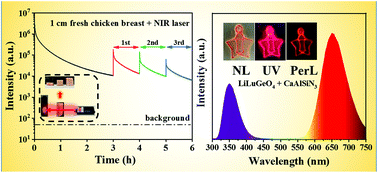Infrared-photostimulable and long-persistent ultraviolet-emitting phosphor LiLuGeO4:Bi3+,Yb3+ for biophotonic applications†
Abstract
Photodynamic therapy needing ultraviolet (UV) in deep tissue is hindered due to the low biological tissue penetration ability of UV light. Here, we demonstrate a persistent ultraviolet-emitting phosphor, LiLuGeO4:Bi3+,Yb3+, which can be re-stimulated by near infrared (NIR) light. Yb3+-doping significantly enhances the trap density without changing the thermoluminescence peak positions. The phosphor can be effectively activated by a 254 nm lamp and exhibits prominent persistent luminescence peaking at 350 nm. The decay time can be recorded much longer than 15 h. This phosphor exhibits simulated in vivo photostimulated persistent luminescence after a longtime decay by using in vitro NIR light penetrating biological tissue. Combined with CaAlSiN3:Eu2+, red persistent luminescence from Eu2+ is obtained. LiLuGeO4:Bi3+,Yb3+ makes up the shortage of excellent UVA persistent phosphors. It is expected to have potential applications as an in vivo renewable excitation source to trigger photosensitizers or fluorescent probes when used for biophotonic applications.



 Please wait while we load your content...
Please wait while we load your content...